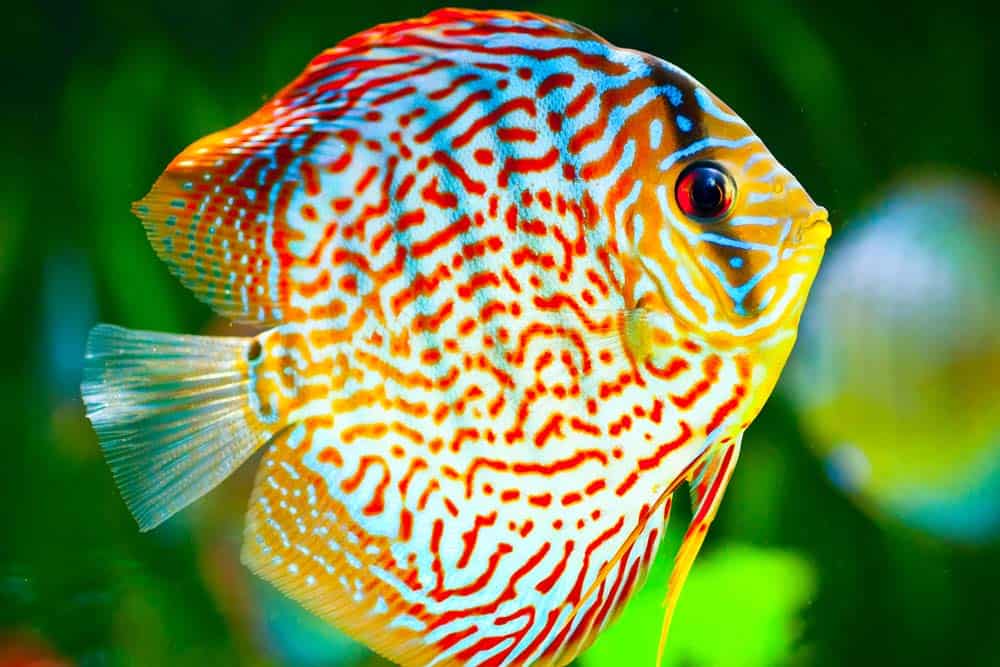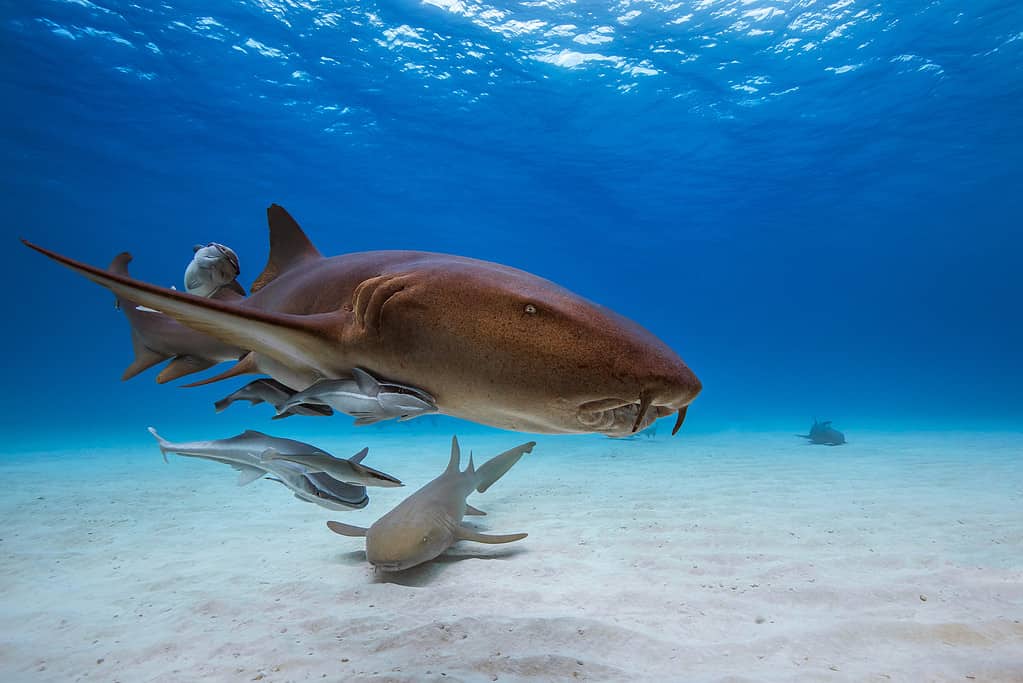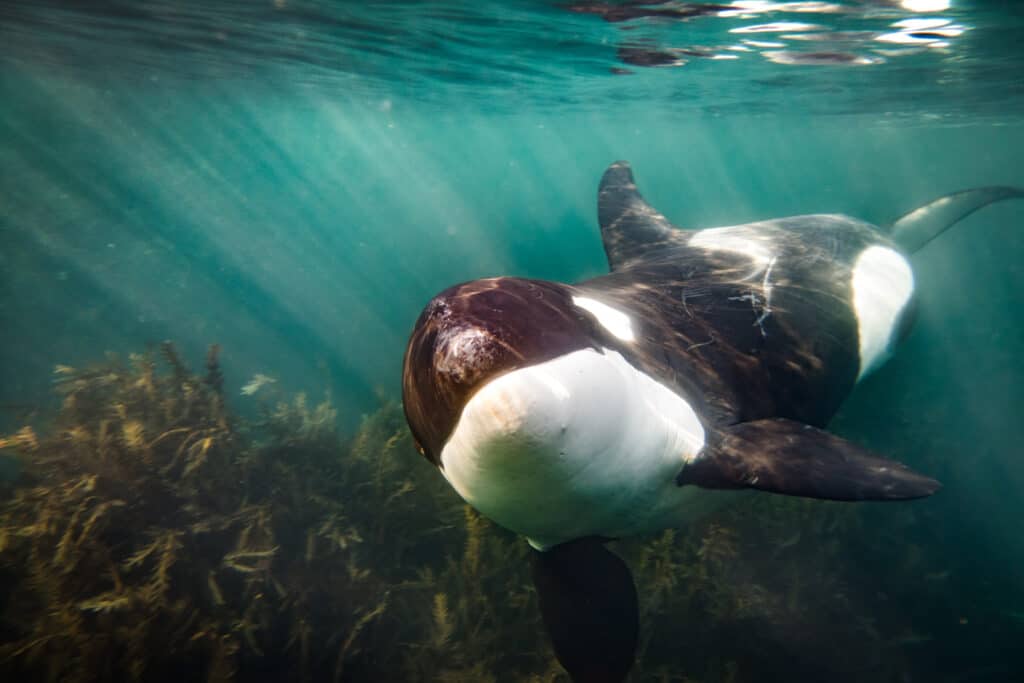Fish can be viewed as very friendly species. They usually make for very good pets. They’re very low-maintenance pets and are more affordable to purchase compared to other animals. Some fish though can be very pricey like the Platinum Arowana, which costs three hundred thousand dollars to have as a pet. Many fish species are herbivores, but there are some that are omnivores or strictly carnivores. Keep reading this article to discover seven carnivorous fish that feast on meat.
Platinum Arowana

Platinum Arowana are very expensive fish.
©Nantawat Chotsuwan/Shutterstock.com
Since this species of fish was just mentioned, why not start here? This three hundred-thousand-dollar fish is one of the more exotic fish species in the world. The prime locations where the Platinum Arowana species (Scleropages formosus) are located are Asia and South America. They’re carnivores. Platinum Arowana fish eats insects, frogs, birds, snakes, and other fish species.
They are four-foot-long fish that weigh up to twenty-five pounds. Platinum Arowana lives in swamps, rivers, and wetlands. Their only predators are humans that fish them for sport or food. The Arowana is a rare species, which explains the very expensive price they have associated with them. They’re silver-colored fish. People also call the Arowana species the dragon fish or the monkey fish.
Red Bellied-Piranha

Red-bellied piranha Pygocentrus nattereri or Red piranha in their habitat.
©Tatiana Belova/Shutterstock.com
Pygocentrus nattereri or the Red-bellied Piranha is not the most friendly fish species around. Sure, they may be attractive by their look, but they don’t always make for the best pet choice. They have a diverse diet. They eat fins that were nipped from larger fish and smaller fish. Not to mention, they also eat fruit, insects, small reptiles, and plants. These carnivores are relatively small fish as they can grow up to at most, a foot long, and weigh up to four pounds. Red-bellied piranha travels in packs of twenty or more. These piranhas inhabit the Amazon River basin and freshwater around the basin system.
What makes them a fierce species is their jaw structure. Piranhas have strong muscles above and around their jaws that create great amounts of force when they chew. Their triangular short and sharp teeth interlock with each other perfectly to lock in their prey and whatever else they may be chewing.
Discus Fish

Discus fish are technically omnivores, as they eat both plants and animals.
©Andrey Armyagov/Shutterstock.com
The Discus fish is a colorful fish species that needs a group dynamic for their social health. They need to be in a pack in order to stay in their best health. They’re technically omnivores as they eat plants and animals. Discus fish’s natural habitat is in rivers and banks in Brazil and Peru. Over the years, organizations made initiatives to protect the species and even instilled a captive breeding plan to help increase the discus fish species. They are a peaceful species unlike their other fish counterparts but only get aggressive during breeding season. Some of their predators are other fish, birds, and turtles.
Sharks

Sharks photographed on a diving expedition to Bimini in the Bahamas.
©Carlos Grillo/ via Getty Images
Now let’s get to the most obvious fish species that are very carnivorous. Sharks are very popular carnivores since they eat fellow sharks and other fish. Some of the larger species eat dolphins, small whales, and even sea lions. Other smaller species of carnivorous sharks eat small fish, squid, crabs, and clams.
Although there are over five hundred different shark species, only twelve of them are known to attack humans. Sharks live in all five oceans: Atlantic, Indian, Arctic, Southern, and Pacific. The Bull Shark and River Sharks are two fish species that can live in both salt and freshwater locations. Most sharks are predominantly based in saltwater areas aside from the bull and river shark species.
Sharks have a cartilaginous body, which means they’re boneless creatures. Their skeletons are composed of the same cartilage as human noses and ears. Some of the popular shark species are the Great White Sharks, Bull Sharks, Cookiecutter Sharks, Nurse Sharks, Hammerhead Sharks, and Tiger Sharks.
The Great White Sharks are the deadliest sharks to humans and boats. They are able to consume twenty to thirty pounds of flesh each bite. A common misconception about another shark breed is that Hammerheads attack humans. However, hammerheads rarely attack humans. Only sixteen Hammerhead shark attacks were reported all-time globally.
Dolphins

Rough Toothed Dolphins
©Cory Fults/Shutterstock.com
Dolphins are popular fish because of how attractive they are at local aquariums and the famous SeaWorld parks. However, they’re unknown carnivores. They mostly eat small fish, crustaceans, and squids. Dolphins eat approximately four to six percent of their body weight per day.
Several dolphin species work together to capture their food. Some of the ways they capture their food are:
- Dolphins encircle a school of fish until they huddle together close enough. Once that happens, the dolphins take their turns eating the group of fish.
- Some dolphins do the “drivers and blockers” method. When they hunt, some of the dolphins play as drivers. The drivers would smack the water surface with their tail flukes to get the fish in a circle. Then other dolphins would block the sides to prevent any fish from escaping.
- An occasional strategy dolphins do is that they would trap fish against sand bars, shorelines, and mud banks. By having them in the shallow waters, it would make them easy food for the friendly, yet not-so-friendly carnivores.
- Bottlenose sharks do a thing called “crater feeding” on small fish. They would dive snout-first into the sand and try to capture unexpected fish.
Dolphins don’t chew their food. They swallow them. They also strip meat from spiny fishes so they won’t have any injuries while eating them.
Oscars

These fish, like other Oscars, may turn into interior designers in their tanks, rearranging the rocks and décor you place inside to their liking.
©Santhosh Varghese/Shutterstock.com
The Astronotus ocellatus is a popular fish species in Venezuela, Peru, Brazil, Ecuador, Colombia, French Guiana, and Suriname in the Amazon River basins. They also inhabit other countries such as Australia and the United States, specifically in Florida. Oscars make for great pets and they gladly eat worms, crickets, and small fish like shrimp. Oscars can grow up to twelve inches in their first year.
Orcas

Orcas are very carnivorous fish.
©Nick Grobler/Shutterstock.com
The Orca or Killer Whale is a massive king of the oceans. Killer Whales are at the top of the food chain and due to their massive size, they require a massive diet. Like other whales, they eat small fish and squids. However, these beasts also eat sea birds, seals, smaller whales, and salmon.
Their ability to hunt and eat is dependent on their other killer whale cohorts. They use echolocation to find their food. By doing so, they’ll call each other out in the sea and find prey based on what their sounds bounce off of. When they capture their prey, they split the food with the other Orcas. The Orca whales are friendly to humans in wild waters. Male Orca whales range from twenty to twenty-six feet long and weigh anywhere between six to eight tons. Female Orcas range from sixteen to twenty-three feet and weigh three to four tons. What some people might not know about Orca Whales is that they’re technically a part of the oceanic dolphin species.
Orca Whales live in the deeper parts of the oceans. They live around the Pacific Oceans near California and Alaska. They also live on the coasts of Australia, New Zealand, Iceland, Norway, the Valdes Peninsula of Argentina, Iceland, and Antarctica. They’re only seasonal visitors in the arctic waters and occasionally swim into freshwater areas. Some Orcas have been seen in the Columbus River in the United States. Orcas also have been seen in the Fraser River in Canada and the Horikawa River in Japan. The Orcas are the largest carnivorous fish in the ocean.
The photo featured at the top of this post is © MD Nakib/Shutterstock.com
Thank you for reading! Have some feedback for us? Contact the AZ Animals editorial team.






